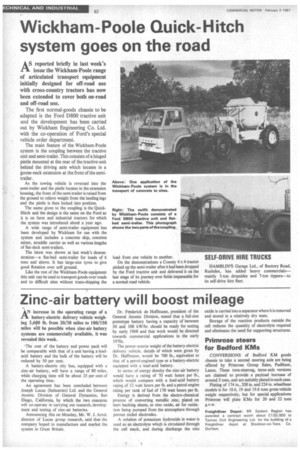Zinc-air battery will boost mileage
Page 64

If you've noticed an error in this article please click here to report it so we can fix it.
AN increase in the operating range of a CV battery-electric delivery vehicle weighing 3,600 lb. from 20/30 miles to 100/150 miles will be possible when zinc-air battery systems are commercially available, it was revealed this week.
The cost of the battery and power pack will be comparable with that of a unit having a leadacid battery and the bulk of the battery will be reduced by 50 per cent.
A battery-electric city bus, equipped with a zinc-air battery, will have a range of 80 miles. while charging time will be about 25 per cent of the operating time.
An agreement has been concluded between Joseph Lucas (Industries) Ltd. and the General Atomic Division of General Dynamics, San Diego, California, by which the two concerns will co-operate in carrying out research, development and testing of zinc-air batteries.
Announcing this on Monday, Mr. W. J. Arrol. director of Lucas group research, said that the company hoped to manufacture and market the system in Great Britain.
Dr. Frederick de Hoffmann, president of the General Atomic Division, stated that a full-size prototype battery having a capacity of between 50 and 100 kW/hr. should be ready for testing by early 1968 and that work would be directed towards commercial applications in the early 1970s.
The power-source weight of the battery-electric delivery vehicle, details of which were given by Dr. Hoffmann, would be 700 lb., equivalent to that of a petrol-engined type or a battery-electric equipped with a lead-acid battery.
In terms of energy density the zinc-air battery would have a rating of 70 watt hours per lb., which would compare with a lead-acid battery rating of 12 watt hours per lb. and a petrol-engine rating per tank of fuel of 170 watt hours per lb.
Energy is derived from the electro-chemical process of converting metallic zinc, plated on inert backing sheets, to zinc oxide, air for oxidation being pumped from the atmosphere through
porous nickel electrodes. ,
A solution of potassium hydroxide in water is used as an electrolyte which is circulated through the cell stack, and during discharge the zinc
oxide is carried into a separator where it is removed and stored in a relatively dry state.
Storage of the reaction products outside the cell reduces the quantity of electrolyte required and eliminates the need for supporting structures.
Primrose steers for Bedford KMs
CONVERSIONS of Bedford KM goods chassis to take a second steering axle are being offered by Primrose Group Sales, Padiham, Lancs. These two-steering, three-axle versions are claimed to provide a payload increase of around 3 tons, and are suitably plated in each case.
Plating of 174 in., 208 in. and 224 in. wheelbase models is for 18.6, 19 and 19.6 tons gross vehicle weight respectively, but for special applications Primrose will plate KMs for 20 and 22 tons g.v.w.
Freightliner Depot: RR Eastern Region has awarded a contract worth about £130,000 to Tarmac Civil Engineering Ltd. for the building of a Freightliner depot at Stockton-on-Tees, Co. Durham.
















































































































































































